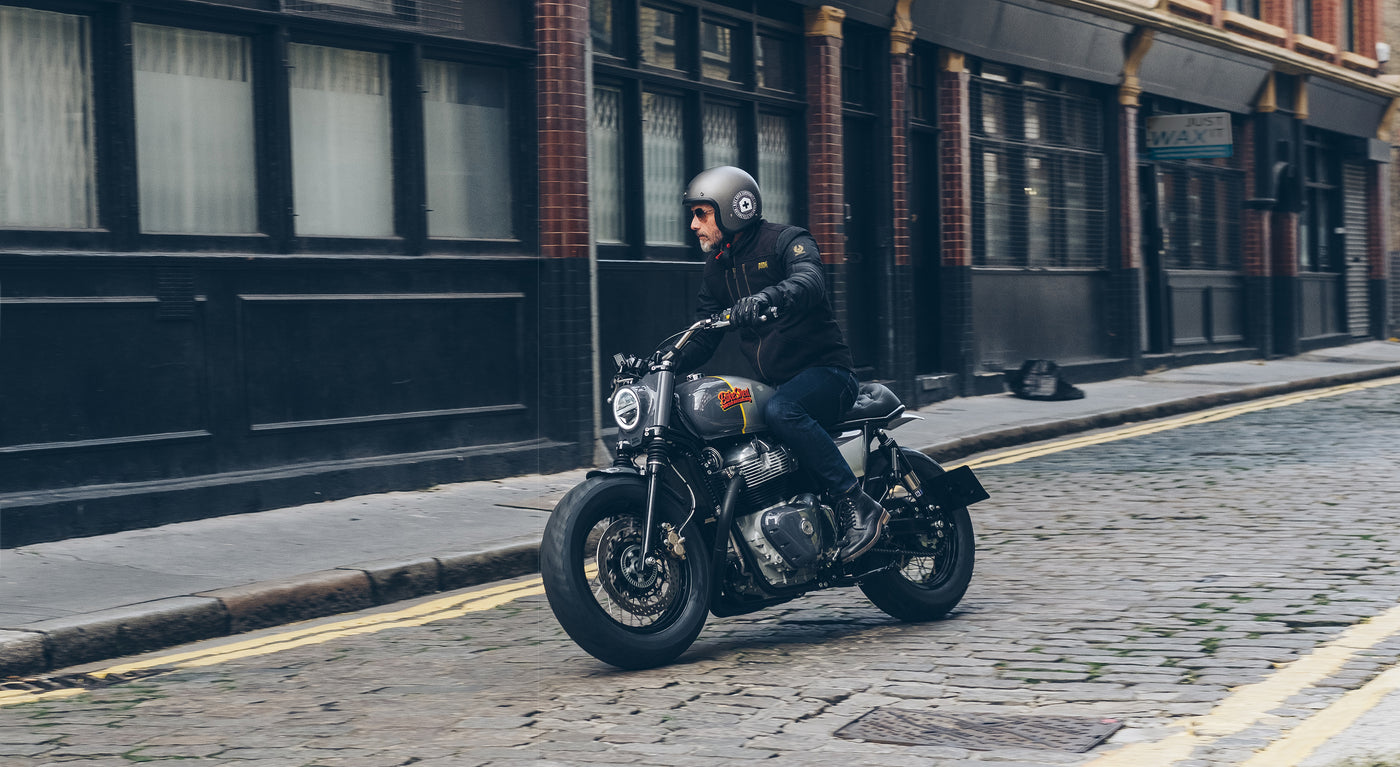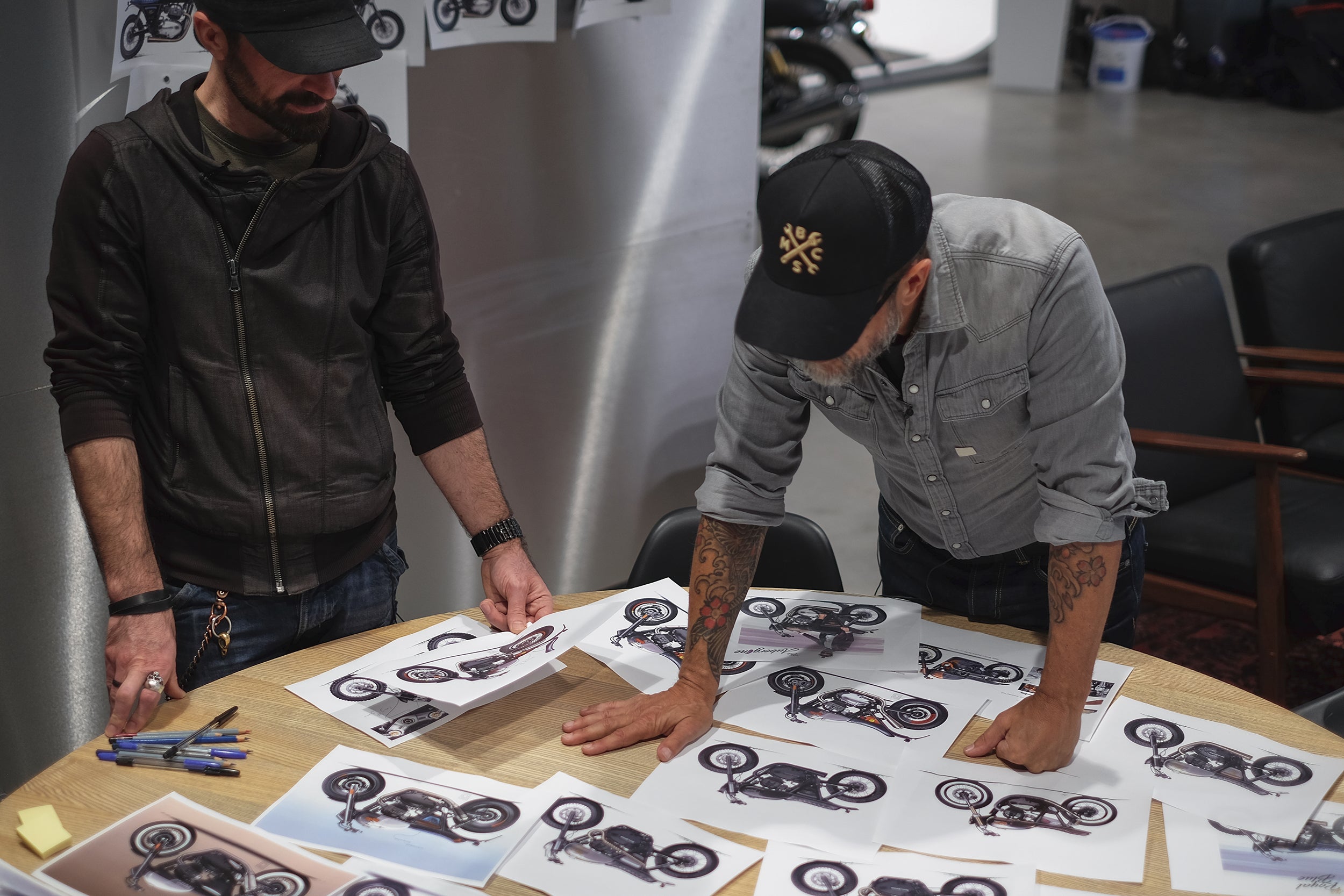Bike Shed x Royal Enfield
By Dutch van Someren - 26 Nov 20


When lockdown hit us all in March this year, not only was that a blow to us as a hospitality business, it also meant no shows or events, so, no Bike Shed Festival, or the 11th Edition of Bike Shed London at Tobacco Dock, our annual cornerstone event where we bring all our tribes together to celebrate the creative and engineering talent behind the motorcycle industry and custom scene. Our annual exhibition is also one of the big things we do each year with the manufacturers, where they showcase new models aimed at the lifestyle genre, backed by aspirational custom builds they commission over the winter, especially for the show.

In recent years Bike Shed has become increasingly close to a few of those brands, including Royal Enfield, who have wholeheartedly embraced the scene and modern moto-culture, and have been championing custom builds from the early days. Without a Bike Shed London show, what else could we do together instead, to create a story, and do something enjoyable over lockdown? The answer was pretty obvious, because many people we knew were already doing it. Start a lockdown build.

Since the new Royal Enfield 650 Interceptor came out it's been a great donor bike for a number of builders, from Baak to Zeus, Thrive to Old Empire Motorcycles. Even Ant Partridge got in on the act on TV for Goblin Works Garage with an outrageous carbon modern cafe racer.

BAAK

THRIVE

ZEUS
I'd already had a few thoughts in my head when I first saw the upright riding position and pretty fuel tank, so we got our heads together with Adrian Sellers and Rahul Sinroja from the RE Technical Centre to come up with a collaborative design we could start building around. The overall idea was to create an urban Brat with some East London attitude.
I had a few key things for the brief, so I started with some photoshop thoughts. Although the bike needed to be a show bike, with a proper paint design, Bike Shed & RE branding and some fun features, it also needed to be a genuinely practical and rideable bike - something I could commute across London on, built to go fast, to stop and to turn, and be fun to ride, even two-up. Adrian and Rahul were focussed on the details and the execution, and we all agreed that we wanted to keep the Interceptor's design and engineering DNA intact. The first draft was pretty basic, and we knew we needed to be bolder.

I've always been a big fan of modern upright Brat Style builds, and many of you might have noticed that I love fat tyres and small wheels, but I also like bikes that go around corners with minimum input. As I've mentioned before with other builds, modern tyres built for 16-inch rims that grace bikes like the Triumph Bobber and Speedmaster, as well as the Harley 48, are designed to be sticky and have a proper sporty profile, so with that box ticked we agreed on a fat-tyred bike - which then needed to be complemented with a musculature stance and silhouette.
Having started out riding dirtbikes with Renthals, often cut down for urban super motos, it was only recently that I discovered the practical joy of the wide backswept handlebar. I had always scoffed at old school desert sleds and flat trackers with bars that seemed to come too far out and too far back, but when I first rode a bike with a set of broad bars I realised the appeal of the extra leverage and the commanding riding position. Another box ticked. It also looked really good on some of the Baak builds I'd seen.

The next elements we all agreed on were a tucked-in headlight and small speedo, while keeping the tank, engine and side-panel shapes. I liked Bates style lights (as per my photoshop efforts), but I also liked the faired-in lights on street-going flat-trackers, and the having the headlight integrated into fork shrouds first seen on some of the JvB Moto builds. Adrian suggested combining this look with Halo LEDs, which would be matched at the back with a thin LED strip frenched-in to the rear sub-frame.
The pipes needed to be custom of course, and low. Not scrambler height. We just needed to work out whether to fit two-it-two single-sided shotgun, two-into-one, or one either side. As a fan of matte black paint my jury was also out on the paint design and my taste in seat upholstery is usually either diamond-stitched or tuck'n'roll, but Adrian suggested we match the Chesterfield sofas at the Bike Shed, complete with buttons. I was a little unsure, but what the hell - it's gotta have some blingy elements to also be a show bike.
To really get the final details down, we decided to involve the Bike Shed and Royal Enfield community, so, after asking pretty much everyone at Royal Enfield in the UK and India design teams to create some design variations on paint, pipes, upholstery and extras, we honed about 40 images down to half a dozen to share on our social media, and asked people to vote for the stuff they liked most.

Four favourites emerged.

Luckily our follower's tastes matched our own, and after a few more posts and video-calls we agreed on the final format. Our muscular urban Brat would wear 16-inch black rims laced to the original hubs, built by Hagon, with Avon Cobra Chrome tyres.
The rear subframe would by chopped and looped with a small up-sweep, framing a dark grey buttoned leather upholstered seat. Baak fenders were cut-down and reshaped to be mounted front a rear. The rear also wore a pair of shrouded Hagon rear shocks, to simplify and beef-up the look of the chassis parts. The pipes were to be a modified S&S two-into-one race full system created for the RE flat track race-bikes, cerakoted in black and without the baffles.
The rear footrests were chopped off and welded back on at an angle that complemented the upsweep of the pipes and the rear subframe. The right side-panel was modified to hold an "emergency" flask of whisky (my favourite tipple) to serve as interesting show-bike feature, and our audience voted for flat grey and metallic silver two-tone paint, split by a yellow pinstripe.

The build had begun, and the bike started to come together, with some elements made from scratch by the RE team and others bolted on. Once everything started arriving at the RE technical centre the bike started to come together very quickly.

The rear swept handlebars are made by Baak wearing Biltwell grips, set on the standard risers behind a Moto Gadget speedo, mounted where the ignition key had been, inset into some some extra material welded to the original top-yoke. The bar-ends were replaced by MotoGadget indicators, which served to be seen from the front and back of the bike.

The frame, tank, engine, front forks, brake system and overall character of the bike remained as it came out of the factory and we kept the original levers, footrests and switchgear, which were all fit for purpose, although we did replace the ignition barrel with a keyless RFID system, which is cool - as long as I don't lose the fob. The headlight we wanted was designed in CAD by the RE crew, who then had it 3d printed, and reinforced with fibreglass before mounting to the bike with a factory fit and finish. I have a feeling they could sell a few of these.

I travelled up the the RE Technical Centre to see the bike a few times during the build, and as soon as those fat wheels and the faired-in headlight were attached the bike looked fantastic, even with un-upholstered foam and no paint.
A few weeks later the finished bike was delivered to the Bike Shed and the minute it rolled off the ramp I knew we'd made something special. The overall size and shape of the bike managed to pull-off being muscular and chunky while being lightweight and manageable. We'd shaved over 20kg in weight and I knew the S&S pipes contributed 12kg to that while adding 12% more horsepower and 7% more torque. There was no way this bike wouldn't be fun to ride.

The first ride came a couple of weeks later, because I'd promised CameraDan that he could be there to capture my genuine first reaction, and that I'd ride with cameras strapped to the bike and a helmet mic to capture my thoughts. The two unknowns for me, were how would the bike fuel on the standard map with the S&S pipes, and how would the bike turn with those fat tyres and wide bars. I know how much work goes into making modern bikes work with both the fuel injection and with the chassis geometry. Messing with the factory set-up in any way often makes a bike worse, even when done by the most experienced custom builders. I assumed I'd need a re-map at the least.

As I pulled out of the Bike Shed's driveway the bike felt instantly right. If the front wheels and tyres had compromised the turn-in or steering that was offset by the wide bars, and the engine was perfectly fuelled right from cold through to be fully warmed up on my city ride.

RE 650cc twins are not fabled for power, but they do deliver torque and grins, but with the extra power and torque provided by the S&S pipes coupled with the huge weight loss, the bike felt punchy and alive. In fact the brand new seat leather felt a little slippery when I gave the bike a handful and I had to grip the tank with my knees to hold my position.

My brief ride from Hackney into Islington was a blast as the bike skipped through the traffic around North London's confusing new junctions, pulling away from every light with half a handful of throttle. The exhaust sounded superb, with a nice burble on idle, and some grumbling backfires on the overrun.

For a budget donor bike, I was impressed by the basics. The clutch was light, the "ByBre" brakes ("by Brembo") did their thing without drama, and the bike simply went where it was pointed. That may all sound a bit obvious, but when you customise a bike things are not usually so good on the first time out.

When I got back to the Shed I kept going, seeking out some cobblestones and speed-bumps to see how the standard front suspension would work with the Hagon rear shock. Again, no drama, and better than a few bikes I've owned with aftermarket suspension on the front and back. A few RE owners I know talk about the bike being a simple joy, and I put that down to being "good for the money" but this bike was a lot better than that, and not because of the custom work we'd done.

We'd built a really lovely bike, and after pricing up all the extras, I worked out that you could buy a brand new 650 Interceptor, and all the parts, for less than £10k ($12,500), and end up with a really good looking, practical custom bike. I genuinely hope we inspire a few copycats.

Watch the Video of my first ride HERE on Bike Shed's YouTube Channel
Gear featured in this video and photoshoot:
BSMC Resistant - BSR01 Jean - Raw Indigo
£60.00
BSMC Resistant - BSR01 Jean - Black
£60.00







